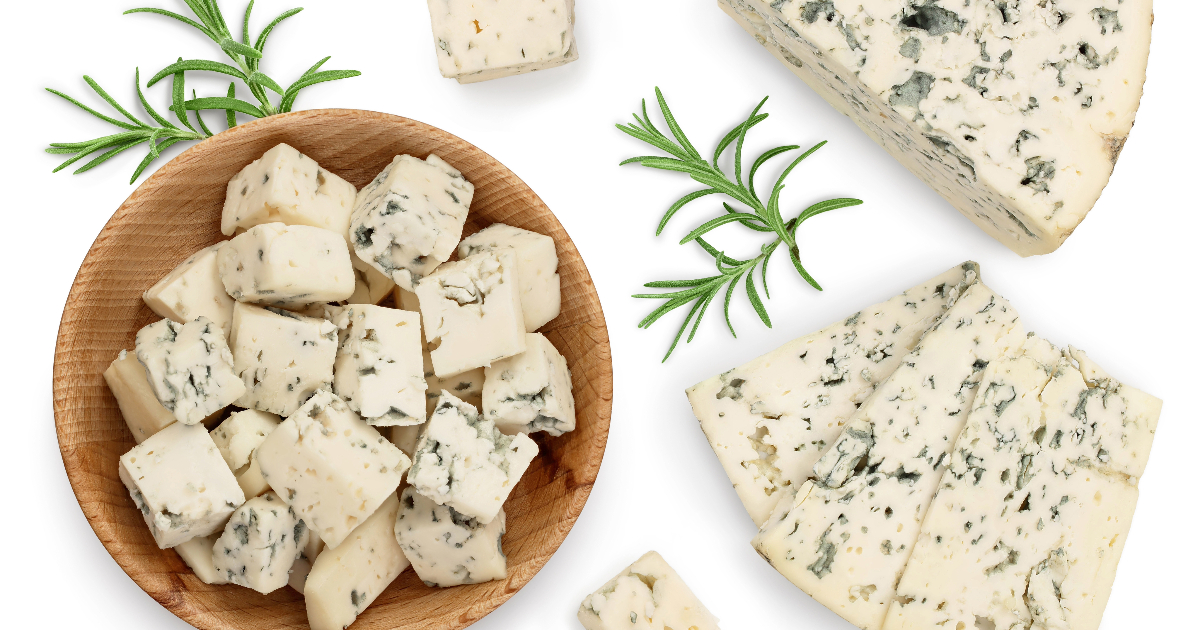Cheese connoisseurs often ponder the complex question - how does the king of stinky cheeses, blue cheese, compare to the refined elegance of brie?

Blue cheese is loved and feared for its intense flavor, crumbly texture, and vein-streaked appearance.
Brie gains popularity for its silky richness and subtle earthiness encased in a bloomy rind.
A Brief History of Blue Cheese and Brie
Blue cheese traces its origins to the caves of Roquefort-Sur-Soulzon in France, where Penicillium roqueforti mold imparted signature veining. This cheese was beloved by Charlemagne, and blue cheese production flourished in Stilton, England and Gorgonzola, Italy.
- Brie emerged in the French countryside, also gaining prestige. As a soft ripened cheese, its rind develops from white Penicillium camemberti mold. Brie rose to prominence as a royal favorite during the reign of King Louis XIV.
The growth of these cheeses parallels the rise of cheesemaking in Europe. Both blue cheese and brie offer centuries of tradition, which modern cheesemakers uphold through meticulous processes.
How Blue Cheese and Brie Are Made
The production of blue cheese and brie differs notably in ingredients, mold cultures, and techniques. Here's an overview of how each type achieves its distinct qualities:
Ingredients
- Blue cheese uses cow's, goat's or sheep's milk. Sheep's milk adds robust funk while goat's milk lends tang. Cow's milk offers a milder flavor.
- Brie begins with cow's milk to achieve its butter-rich notes. Cream is sometimes added to boost the fat content.
Mold Cultures
- Blue cheese depends on Penicillium roqueforti or glaucum molds introduced into the curds or injected into the body. This creates blue-green veining and pungent flavor.
- For brie, Penicillium camemberti is spray-inoculated onto the rind. As it grows, it ripens the cheese from the outside in for subtle earthiness.
Cheesemaking Steps
- Blue cheese curds are mixed with mold spores, then pressed into wheels to incubate. Needles may inject extra oxygen to feed mold growth.
- Brie begins with a firm, chalky interior. As white mold develops on the rind, the interior ripens to a luscious creaminess.
The specialized mold cultures remain the crucial distinction between blue and brie. Their strategic use during cheesemaking results in dramatically different visual and tasting experiences.
Key Characteristics of Blue Cheese vs. Brie
From first glance to first bite, blue cheese and brie bear little resemblance beyond their creamy textures. Here's how they compare in terms of appearance, aroma, texture and flavor:
Appearance
- Blue cheese has blue-green veins radiating through a white to yellow interior. Some varieties are speckled while others appear more marbled.
- Brie boasts a bloomy white rind wrapping a pale yellow interior. Young brie has a chalky center that softens with age.
Aroma
- Blue cheese smells robust, sharp and peppery - sometimes almost musty. This comes from the mold and aging.
- Brie has a mild mushroom-like aroma. At peak ripeness, some ammonia aromas emerge.
Texture
- Blue cheese ranges from crumbly to creamy. Age reduces crumbliness.
- Brie starts firm and becomes oozy, ultimately oozing like gelato. The rind remains velvety.
Flavor
- Blue cheese tastes tangy, salty and spicy with blue mold notes. It can be richly beefy or evoke fresh grass and herbs.
- Brie tastes mellow, nutty and buttery with subtle earthiness. Notes of honey, vanilla or nuts may come through.
Clearly, the intensities differ dramatically - blue cheese is a flavor powerhouse compared to brie's finesse. But both impart sophistication.
Pairing Suggestions for Blue Cheese vs Brie
The boldness of blue cheese and the restraint of brie call for different pairings to bring out their best:
Blue Cheese Pairings
- Fruit like pears, apples or figs balances blue cheese's saltiness.
- Nuts like walnuts or pecans add crunch and complement the moldy flavors.
- Sweet wines like Port, Sauternes or ice wine work beautifully with the intensity.
- Hearty breads stand up to the crumbles without competing.
Brie Pairings
- Stone fruits, fresh berries or preserves accent brie's creamy texture.
- Crackers or baguette slices serve as neutral yet sturdy vessels for lush brie.
- Sparkling wines and crisp whites like Chardonnay pair nicely without overpowering.
- Herbs and nuts bring out brie's subtle earthiness.
Mild, sweet and bright flavors tend to balance brie best. For blue cheese's verve, go bold or go home!
FAQs
Is blue cheese just moldy brie?
No, blue cheese and brie use different Penicillium mold cultures strategically during cheesemaking. Blue cheese is inoculated throughout while brie's rind is surface-ripened. So blue cheese isn't just a moldier brie - the flavors develop very differently.
Is one healthier than the other?
Not significantly. Both are high in fat, sodium and cholesterol as full-fat cheeses. Brie has slightly more calcium while blue cheese has a bit more protein. But they're both considered equally indulgent options, to enjoy in moderation.
What wine matches both blue cheese and brie?
Sparkling wines like Champagne or Prosecco pair nicely with either, acting as a palate cleanser between bites. Light, acidic white wines also complement both flavors. Unless you dislike strong mold flavors, sweeter wines specifically suit bold blue cheese.
Should blue cheese be served cold or room temp?
Room temperature allows the nuanced flavors of blue cheese to shine. The chill of refrigeration suppresses its aroma and taste. Let it warm up before eating for the full experience. Brie is also best around room temp.
Which cheese has a stronger smell?
Blue cheese has an undeniably stronger aroma than brie. The ammonia released especially by potent blues can be off-putting at first sniff. Brie has an earthy musk but doesn't typically approach blue's pungency. For some, this makes brie more approachable.
Conclusion
Blue cheese brings bold, funky flavor punched up by Penicillium mold patterns. Its crumbly fissures in sharp white contrast the pop of blue veining.
Brie delights with velvety richness thanks to surface ripening that progresses inward. Its subtle earthiness blooms within a snowy rind.

